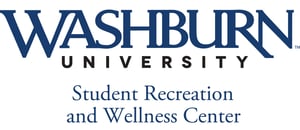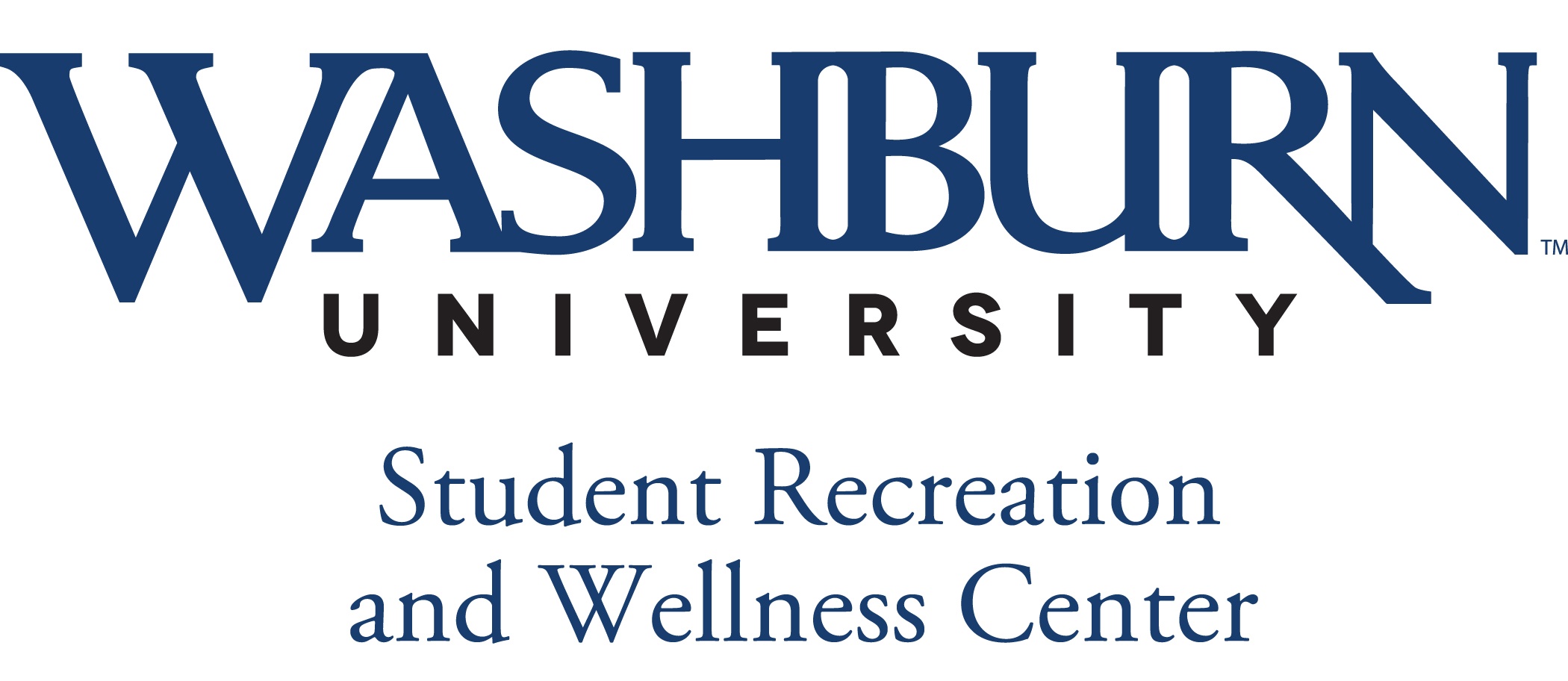Click here to download a PDF of this case study. 
When 57-year-old Tara Porter shows up at Washburn University's rock climbing wall in the school's Student Recreation and Wellness Center, someone usually asks her if she needs help or wants to sign up for a class. She smiles, grabs her climbing gear and says, "Thanks. But I'm already rockwall certified." She tightens her climbing harness, clips in her carabineer, and starts climbing the 30-foot wall.
In the past year, Tara has taken up rock climbing, started going to weekly yoga classes, completed a race, and participated in monthly health challenges. It's all part of the Washburn University Employee Wellness Program designed to create a culture of health.
"I was on the fence about the wellness program for a long time," says Porter, who works as an advisor at the university. "I pretty much had it in my mind that I didn't have time for it. When five o'clock rolled around, I just wanted to go home and crash or do other things."
And then one day, it happened. Tara decided to get involved in the University's wellness program on her own terms. It's the kind of success story every wellness coordinator dreams of after all the efforts to increase engagement, create a culture of health, and generate ROI.
Now Tara is an ambassador for the University's wellness program that enjoys a 64 percent participation rate, successful wellness initiatives,
and an estimated $4 million in ROI since the program launched in 2006. And at the heart of this thriving wellness program is the evidence-based health risk assessment by Wellsource.
Assessing the Population
When the Student Recreation and Wellness Center (SRWC) opened on the Washburn University campus in 2004, the 37,000-square-foot fitness facility re-energized on-going efforts to create an employee wellness program, says SRWC Director Joel Bluml. The three-court gymnasium, fitness equipment, rock climbing wall, and indoor track provided the perfect setting to house the Washburn University Employee Wellness Program.
When university president Jerry Farley gave a green light to move forward with launching an employee wellness program, the first wellness screenings using the Wellsource® Personal Wellness Profile™ Health Risk Assessment were organized by Bluml and then Wellness Coordinator Celeste Ehrenberg. The current Wellness Coordinator Coletta Meyer joined the team in 2013. She is responsible for actively managing the program, developing interventions, and providing wellness consultations to University employees.
"I'm here to help as many Washburn University employees as I can achieve a better state of wellness," says Meyer. "Not all of us are at the same place, but our program is designed for all employees regardless of their wellness state. We're here to support and guide people as well as provide healthy opportunities that facilitate growth in the multiple dimensions of health and wellness."
In the first year of the wellness program, about 48 percent of Washburn employees completed the biometric screening and health risk assessment. And since then, improvements to the wellness program have increased engagement to achieve a 64 percent participation rate that continues to grow. Joel and Coletta also discovered the value of partnering with the right people to make sure tests like waist circumference, blood pressure, cholesterol, glucose, and body composition are measured correctly as part of the screening process.
Discovering the Results
When HRA reports were made available, one Washburn University professor reviewed his test results and found that his numbers didn't match up
with healthy standards, Bluml recalls.
"His numbers were off by so much, he thought something must be wrong with the test results," says Bluml. "That motivated him to schedule another screening with his doctor, and that's when he found out he had cancer. Luckily, the cancer was caught early on and
treated successfully."
The Wellsource® Personal Wellness Profile™ HRA reporting tools helped identify major risk factors for Washburn University employees. Results from the Executive Summary Report showed that the leading health risks for university employees included high blood pressure, high cholesterol, stress, lack of exercise, and weight management. The reporting data also provided valuable information to help make decisions about what areas to focus on and what interventions would be the most effective.
"One of the things I really like about the Personal Wellness Profile™ is the readiness for change factor," says Bluml. "We can identify the health risks we should focus on, which is nice. But we are also able to see if people are ready and willing to change, which has the
potential to be transformative."
"Assisting people with quitting smoking is a good example. If we learn that people who smoke aren't ready to quit, promoting a smoking cessation program isn't going to work. Understanding their readiness to change allows us to begin with an intervention that can start at pre-contemplation, get them thinking about quitting, and then move them towards taking action."
For Washburn University employee Jeremy Wangler, the HRA results that showed him he had high triglyceride and low HDL levels got him thinking
about improving his eating and exercise habits. But it wasn't until he watched the documentary, Forks Over Knives, that he was ready to change. He adopted a plant-based diet, started exercising, and lost 80 pounds. Jeremy was able to lower his triglyceride level and raise his HDL to a healthy level. His positive results motivated some of his family members to make healthy lifestyle changes too.
"We're seeing individuals make changes to improve their health more and more as our participation rates increase," Bluml says. "Our aggregate data indicates that many of the employees participating in our program are on the zero-trend Dee Eddington talks about. In other words, if we can keep people's health risks from getting worse, we feel we're doing a good job. Our data also highlights that employees who have participated in our wellness program since its inception have improved their wellness scores from year to year, and they've improved
significantly as a group."
Managing Interventions and Incentives
"We provide a lot of different programming options to encourage participation and address the key health risk factors in our population,"
says Meyer. Bluml provided this analogy, "Our approach to getting the message out there is more like a dripping faucet than a fire hose. Constant reminders about healthy living will get more results than overwhelming people with a plethora of information all at once."
Washburn employees can be seen providing healthy snack options at meetings. The EWP encourages employees to participate in the Alumni Fun Run/Walk. A weekly email, Wellness Wednesdays, is filled with health tips and information. "Our goal is to create constant buzz on campus about wellness. Does it mean everyone at Washburn is living healthier? No. But wellness is definitely on people's minds," according to Bluml.
Wellness interventions at Washburn also include a series of six- to eight-week classes offered throughout the year to help people set personal goals for health and wellness, eat healthier, get more exercise, and even train to complete the 5K Alumni Fun Run. In addition, there are team
challenges, wellness-focused quizzes and mini-assessments, lectures, and friendly competitions where employees can win a healthy lunch for their entire office. Employees also have the opportunity to meet individually with Wellness Coordinator Coletta Meyer for one-on-one wellness consulting.
"It's really rewarding to meet employees in person and design customized programs to help them be successful and make healthier choices," says Meyer. "We talk about their HRA scores and risk factors, their job, and things going on in their life. I do individual fitness testing with employees and provide them with an exercise prescription. It's a great way to help people see where they're at, give them some goals to work towards, and teach them how to exercise and live healthier."
Employees who participate in the Washburn University wellness program can earn incentives valued at up to $150 a year based on three levels of participation. Employees can earn incentives by completing the Personal Wellness Profile™ HRA and health screening, exercising 30 minutes a day, getting preventive exams, practicing safe driving habits, and making healthy lifestyle choices. Many employees use the financial incentive
to be reimbursed for the annual fee to use the Student Recreation and Wellness Center. Others choose to be reimbursed funds they
have contributed to their health-related flexible spending account or elect to have the incentive placed on their university identification card which allows them to spend the funds as cash on campus. Employees can even be reimbursed for the costs of an outside gym membership.
Calculating ROI
The Wellsource® Productivity and Economic Benefits Report (PEBR) is one tool organizations use to calculate their financial savings by offering a wellness program. Using participant data from the HRA, the PEBR provides information on projected savings in healthcare costs, absenteeism, and productivity. This report can also calculate projected savings by the overall number of health risk factors reduced in an organization.
It's one way to calculate wellness ROI. Some organizations compare actual healthcare costs from year to year. And Washburn University uses another approach.
"When we were trying to wrap our minds around the ROI piece of administering a wellness program, we decided to utilize the meta-analysis on wellness ROI by Larry Chapman published in the American Journal of Health Promotion," says Bluml.
"It's based on 62 studies that show a program structured similar to ours at Washburn can consider using a 6 to 1 return on investment ratio to
calculate wellness ROI."
Choosing to use a more conservative $4.30 to $1 return on investment in wellness, the Washburn University Employee Wellness Program estimates it has generated approximately $4 million in savings since it launched in 2006.
"I think it's important to point out that ROI is more than just a number," says Bluml. "It can include everything from improvements in employee morale, employees who look and feel better because they are in better health, lower healthcare costs, reduced accidents on the job, decreased
absenteeism, and increased productivity. Research also suggests there is a positive correlation between employee wellness programs and employee recruitment, retention, reputation, and presenteeism."
Making a Difference
With a 64 percent participation rate, Joel and Coletta know there's still room for improvement to engage more university faculty and staff members. Managing an effective wellness program is always a work in progress. And you never know when some wellness message, email, or invitation to participate in a health challenge will motivate someone like Tara Porter to take action, get involved, and improve their
health and their life.
"We evaluate every single program that we run, and then we make changes to improve it," says Meyer. "We work pretty hard at providing a variety of wellness programming options to have the best impact and reach the most people. Our goal is to educate employees about healthy lifestyle choices and encourage them to participate in quality programs that will enhance their health and quality of life."
Lessons Learned
1. Sustained efforts to create a culture of health increase engagement.
2. A Health Risk Assessment can save someone's life.
3. Effective interventions require knowing your population's risk factors and readiness for change.
4. Support from leadership can help encourage participation.
5. Multiple delivery platforms work best to distribute wellness program information.
6. The right incentive can motivate people to make healthy lifestyle choices.
7. Successful wellness programs evolve and change over time to keep participants engaged.
8. The Wellsource® HRA provides valuable data to help identify risk factors for a population, choose interventions, and measure wellness program results.







